From Food Desert to Food Oasis, The St. Louis Grocery Market Has Changed
For many years St. Louis’ near south side was a food desert:
Food deserts are defined as urban neighborhoods and rural towns without ready access to fresh, healthy, and affordable food. Instead of supermarkets and grocery stores, these communities may have no food access or are served only by fast food restaurants and convenience stores that offer few healthy, affordable food options. The lack of access contributes to a poor diet and can lead to higher levels of obesity and other diet-related diseases, such as diabetes and heart disease. (USDA)
With the recent opening of the Save-A-Lot in Jefferson Commons and Fields Foods last week, this former food desert is now a food oasis. St. Louis still has a number of food deserts, but this is slowly changing. Let’s take a look at the near south side.
Jefferson & Lafayette used to have a Foodland, but it closed years ago. On the SE corner an ALDI used to serve the same customer base, but it also closed years ago. Less value conscious customers have always had to go outside the area for their groceries. Now the grocery needs of most everyone should be met with two new grocery stores: Save-A-Lot and Fields Foods.
Save-A-Lot
The Save-A-Lot opened in the southern portion of the old Foodland space, now known as Jefferson Commons. I was at the community meeting in May 2012 when it was announced that Save-A-Lot was announced as the grocery store coming to the development, the reaction in the packed gymnasium was mostly disappointment. Save-A-Lot, based in Earth City, is a subsidiary of Minnesota-based SuperValu.
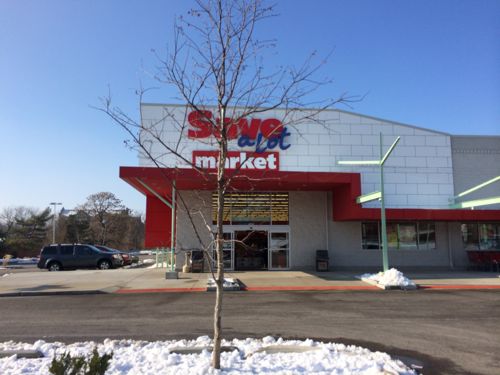
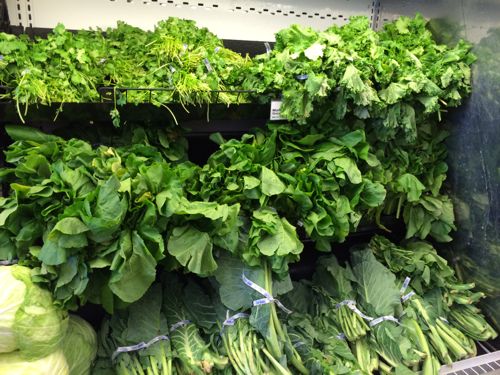
I’m not a huge fan of Save-A-Lot or ALDI’s, but I’m also not too snobby to shop at either, on occasion. We stopped in to shop at the new Save-A-Lot in December and I was very impressed. Sure, cases of product with the front of the boxes cut off doesn’t make for a special shopping experience. As a label reader, I rarely found an item with a bar code that didn’t contain items I won’t consume (high fructose corn syrup, for example). That said, the fresh greens & other produce was much better than I expected, beautifully displayed at the entry too.
Nice for the immediate area, but nothing to make me hop on a bus every week to shop.
Fields Foods
This new concept is what changes the local grocery market. Years ago downtown developer Craig Heller opened City Grocers to help sell more lofts. Better than nothing, it was an upscale convenience store: limited selection with high prices. When Schnucks opened Culinaria in 2009 Heller wisely shuttered City Grocers. Fields Foods is also an effort by a real estate developer, Chris Goodson of Gilded-Age, but the similarities end there.
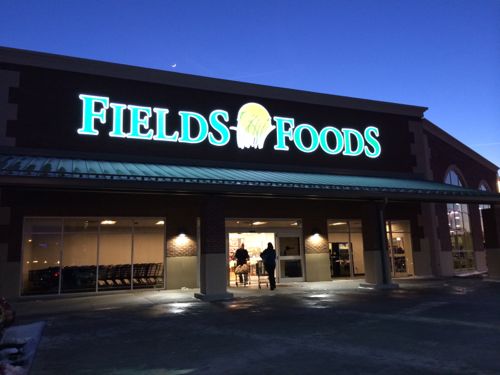
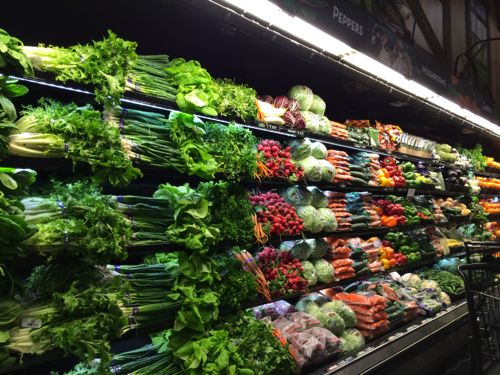
Fields Foods is part of a bigger concept:
The St. Louis Food Hub is a unique social enterprise that distributes, processes and retails foods from local farmers and food producers. Headquartered in the midst of the city’s historic Lafayette Square district, the food hub is a collaborative effort between three businesses that share the same vision.
- Fields Foods is a full-service grocery store specializing in bringing local foods to local shoppers.
- Virtual Food Hub is an online platform where local farmers and those who purchase their products connect to do business.
- Farm to Family Foods is a distributor, processor, and wholesaler of local foods.
Together, these Food Hub companies are pioneering the effort to consolidate a regional food system, setting new benchmarks for food desert remediation and breathing healthy life into urban renewal.
At the opening they talked about opening more Fields Food stores. Perhaps on the near north side?
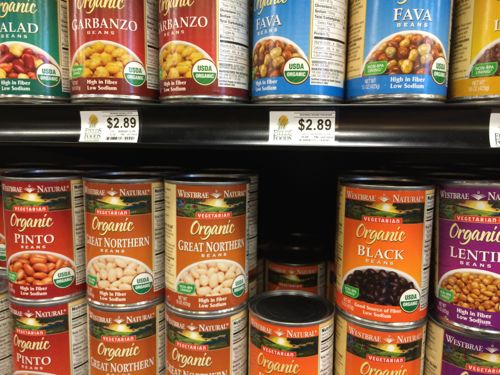
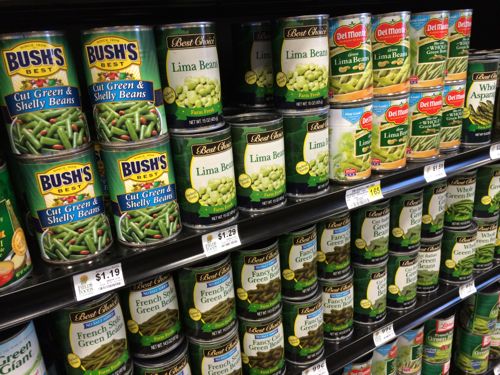
The Best Choice brand is an affordable line of products from Kansas City based Associated Wholesale Grocers, these products are also available at stores like Save-A-Lot and Straub’s. Fields Foods has a nice salad bar, hot food bar, deli, etc. We were there for the ribbon cutting on Friday and returned on Saturday to shop.
Impact
Fields Foods is larger than Culinaria, so it’s able to offer a wider selection of products. I can see myself taking the short bus ride to shop here once or twice a week. Others may stop by when driving to/from downtown.
The other store that will be impacted is Local Harvest Grocery, on Morgan Ford at Arsenal. Local Harvest carries a decent selection of organic and local products, Fields Foods will cut into that market. How much isn’t known yet.
When Whole Foods opens at Euclid & West Pine in 2015 it’ll be equal distance to downtown as Fields Foods, so it’ll be interesting to see what happens then. I’ve been frustrated by Culinaria’s selection for years, their recent modifications improved things a bit. Hopefully Fields Foods will be a wake up call to Schnucks that they can’t continue merchandising Culinaria the way they have been.
Future
As mentioned, we still have some areas that are a food desert. These areas could benefit by having a Fields Foods to provide a source for quality food and employment. I also wonder if the changes in the local market, especially the upcoming Whole Foods, will cause Trader Joe’s to get serious about a location in the city? I don’t like the initial site plan of Midtown Station, but the location would be excellent.
Also, Fields Foods might fail, predicting the grocery market isn’t easy. National chain Wild Oats, before being bought by Whole Foods, opened a second St. Louis area store in Chesterfield. Despite the affluence of Chesterfield the store failed and closed. After sitting vacant for a few years, a Trader Joe’s opened in the space. Local Harvest Grocery opened a 2nd location in Kirkwood in late 2012, but it closed less than a year later.
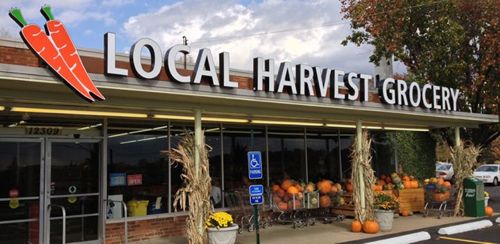
I think Fields Foods is making a big enough entry into the local grocery scene that some other stores, like Culinaria, will notice. Given the population isn’t increasing, every dollar spent at a new store is a dollar not being spent at an existing store.
I hope Fields Foods propers and opens new locations, each with good pedestrian access.
— Steve Patterson
These two new stores are great (especially “Field Foods”, I plan to shop there but I’m sort of a food snob). I just don’t get the idea of calling Lafayette Square and the surrounding neighborhoods “food deserts”. Not only are they full of fine restaurants, they are close to Culinaria downtown, Vincent’s in Soulard, and Soulard Market. Not far away is the Grand and Gravois Schnucks. A friend of mine lives in Soulard, and the Grand and Gravois Schnucks has been her store of choice for twenty years.
Calling this area a food desert is a bit of an exaggeration. I bet there are lots of subdivisions in the burbs with grocery stores no closer to their homes than most sections of the city, including all of the North City. Even during snow.
People make such a big deal about running out of bread and milk during snows, but what’s the big whoop? If it gets bad enough you can friggin’ walk to the store. It’s not like we’re in Siberia, folks. Or in the middle of the Sahara.
It’s 1.7 miles from Fields Foods to Culinaria. From Save-A-Lot it’s 2.5 miles to Culinaria. It was most definitely a food desert.
2 or 3 miles is a long way if you’re walking; it’s not that far if you’re driving (< 5 minutes) or taking the bus (< 10 minutes).
My understanding is that a food desert has more to do with poverty than actual distances. Using your logic, much of Ladue and Wildwood would also be considered food deserts, as well, as would every rural area. Just having a grocery store "nearby" does not mean that it will be stocked with high-quality, affordable produce and fresh meat, nor does it mean that customers won't choose "junk" food over the "good" stuff. People choose to eat "substandard" food because, a) at's all they can afford, b) they don't "know" (or care) about proper nutrition, and/or c) they prefer the taste of salty, greasy food over that of raw vegetables.
If someone could make a buck selling good food to poor people, guess what? They would! The reason that so many poorer areas are "food deserts" is that the residents don't (or can't) support the types of grocery stores that middle class and rich people "get". Retailers aren't stupid – they sell what sells, in any particular market, and don't sell what doesn't sell, in said market. There is no giant conspiracy to screw poor people, there's just this desire to be profitable!
Vincent’s has been serving Soulard and the surrounding area since what, the 70’s? and that was a National store long before an Aldi’s.
But heck, it can be whatever it wants to be, it won’t survive if people shop on-line or they have lousy service/quality.
The building that’s now a Save-A-Lot was originally built as a Kroeger in 1984. An ALDI store was located on the site where the Union Club building was built within the last decade.
Time will tell . . . . If local residents and non-residents who value these types of foods patronize these stores, they should remain profitable and open. If not, expect selection and quality to suffer, and the stores to eventually close. Your needs and desires are different from mine, so we shop differently, favoring different stores. Your dollars count as “votes”, just like mine do – the grocery business is a tough one. And as you point out, the success of new entrants can negatively impact current retailers – is there truly a “desert” in this part of town? Or just a limited market for grocery stores, especially those that specialize in healthy and organic?
I think the stores will do well, as both Lafayette Square and Soulard are pricey areas. Nearby areas of S. Grand and Compton Heights will support these as well, as should Botanical Heights. A “Mini-Dierberg’s” for the “New Southside”.
deirbergs can take their suburban biz model and shove it up their ass
Diebergs and their feud with the City goes back to the 70’s. I agree…they can shove it.
Please tell me more, that’s before my time.
if you think the cwe is as close to downtown as fake laf sq/ peabody darst webbe, get a map
No, but I think the CWE, the Northside, and the Southside all have grocery stores as close to them (or closer) than the subdivisions in Arnold located off of 141, halfway between Hwy 30 and I-55, and no one is calling those places “food deserts”.
“When Whole Foods
opens at Euclid & West Pine in 2015 it’ll be equal distance to
downtown as Fields Foods, so it’ll be interesting to see what happens
then.”
no it wont
Some of us find it interesting to see how buying habits shift when a new store enters a market.
Steve, I too find it interesting, but fields foods will be much closer to downtown than whole foods, that’s my point. Lafayette and 14th is a lot closer to downtown than euclid and west pine, you siad they were equal distance.
You’re right, it seems I just think of taking the #10 westbound on Olive/Lindell as being faster. From my place at 16th & Locust it’ll take 14 minutes to get to Fields Foods vs 23 minutes to get to Whole Foods. My decision will likely depend on what I need to get and the prices. Whole Foods will carry items I can’t get closer to me.
And a Whole Paycheck is not the answer for many poor people; a Walmart would be a better one
“Wump” LOLOL! What a great pseudonym name!
Actually, 3 census tracts near Arnold, including 2 on the southwest side of 141, ARE defined as food deserts by the USDA: http://www.ers.usda.gov/data-products/food-access-research-atlas/go-to-the-atlas.aspx#.UszC73azKph
I was really excited about Fields Foods opening. I’d heard about it then went to their website. It’s all nature-local-healthy-sustainable. Excellent! But none of that is true. None of the fruits and vegetables I saw were organic. Fresh was debatable. On the shelves there might have been some organic or “healthy” options but prepackaged junk ruled the day. This is no better that a Schnucks. It’s just in a warehousy building. And you know, if that’s all they claimed to be then great, it’s awesome that there’s a store in that area.
How about a different business model? A food coop. A large food coop. Everything you’d need at a grocery store. I was a member of this coop for years (http://www.foodcoop.com/) and I’d give my right arm to have one like it here. You have to work 2 1/2 hours every four weeks. That and a $100 deposit you get back when you leave and you’re in. (The $100 can be spread out over six months I think by the way). The labor savings and product turnover make this place 20-40% cheaper than other stores in Brooklyn.
If I was to try to start one my idea is getting a small group together to get the place open and asap open all governance up to anyone who’s a member. It’d be a worker model. That’s the only way to make at as affordable as it could be. I envision perks like $1 off your bill with a bus pass. But that’s for the members to decide I suppose.
Could it work here? Seriously. What would be my biggest hurdles?
It already exists: in Old North.
I’ll be damn, sure enough, found a link, doesn’t look like the Old North web site has been updated recently. They say the co-op model they are using will eventually require working at the store. I was a co-op member a while back in another state (Hawaii), definitely a good alternate way to shop. Hope Old North pulls it off.
Not surprised the veggies might look a little tired at Fields Foods, in this climate a system of greenhouses would be the best way to get supplies rather than national shippers, which is what I’m sure they do. The first thing I thought looking at Steve’s photo of the veggies is that they need a big turnover to maintain that display.
http://oldnorthgrocery.com/
Didn’t the Old North food coop recently closed its doors. Trying to remember where I read that. Its a tough economic model when your paying workers and having to compete against large distribution networks because you don’t have a year around growing season.
From last March: http://news.stlpublicradio.org/post/old-north-grocery-co-op-need-volunteers-stores-survival
I went a couple of years ago but it was a tiny, sad little cinder block building with a VERY limited selection. Bless em but it wasn’t a place where a person/family could do much of their shopping. I don’t know if they closed. They had that small urban farm thing going on too.
And from today’s Post-Dispatch: “Local Harvest Grocery and restaurants face imminent closure, seek help” . . . good intentions only go so far – stores need customers to stay open – money talks . . . .
Their ill-fated expansion to Kirkwood may have killed them. As for the original location, it appears to be doing fine on its own, but not enough to cover the losses from Kirkwood.
Fields Foods btw is looking to expand throughout the region.
only when SPENT LOCALLY and not buying things like Christmas trees and HDMI cords on line.
If we buy a live tree this December it will be online from a local company. Businesses in St. Louis are also connected to the innerwebs…
There’s a difference between shopping online, locally or not, and spending one’s money in local brick-and-mortar stores. One major component of urban living (that you repeatedly advocate for) is street-level retail with display windows next to the sidewalk. Guess what? All those stores (that you want) need customers (like you) spending money in their stores! The reason that there are so many vacant storefronts in downtown St. Louis (and not in downtown Clayton), the reason that there is no drug store or Target or Walmart in downtown, and the reason that Local Harvest is apparently on the verge of closing is pretty simple – too many customers, like you, like me, like Moe, CHOOSE to spend their money elsewhere! It doesn’t matter if you/I/he choose to spend it online with a local company, online with Amazon.com, on ebay, at Gravois Bluffs, at Trader Joe’s (in the suburbs), at Target (in Hampton Village) or at the Walmart in Maplewood, IT AIN’T GETTIN’ SPENT in the types of structures that you want saved and built on every major street corner in the city.
If you’re going to talk the talk, you gotta walk the walk! Radio Shack sells HDMI cords (as does Target). There’s a Radio Shack on Hampton (3517) a few blocks north of Target (where you shop), in an older (relatively) retail structure that has show windows facing the sidewalk and parking on the side of the building. Yes, it IS your choice – you can order online, you can buy it at Target OR you can buy it from the type of URBAN STRUCTURE that you want to see more of! Money talks, actions speak louder than words – it may cost more, it may be less convenient, but it’s important – stores stay open for only one reason, TO MAKE A PROFIT! No (not enough) sales = no (not enough) profit = no (not enough) store(s)! Yes, Moe was being snarky and sarcastic, and yes, I’m being repetitive, tiresome, libertarian and free-market, but it shouldn’t be surprising that Local Harvest is feeling the impact of a new competitor opening up not that far away. Unfortunately (for urban businesses, as for every other business), money talks – there only so many dollars to be spent and only so many customers to be wooed. The pie doesn’t get any bigger, it just gets sliced up differently – it IS your choice . . . .
Totally agree JZ…and that’s why I’ve stopped taking such interest in this page. It’s easy to talk the talk, but harder to walk the talk. I wish I could say we spend 100% locally, but we don’t. We do spend as much as possible though…be it Christmas trees, HDMI cords, dining out, etc. And my family DOES shop at Local Harvest and their related Tower Grove Farmers Market.
Having a car makes its easier to drive around to find what you need. When you don’t have a car buying something as simple as an HDMI cable could take hours or paying a higher price because of limited retail options. Your comments demonstrate how you fail to understand the issues faced by low income shoppers.
And If I need an HDMI cable, I don’t take hours shopping around, I either go online to see who has what locally or I just head out to someplace like Best Buy, Radio Shack, Target or Walmart and buy it at the first place that has one the right length – I’m not going to burn through a gallon or two of gas trying to save a dollar or two. If anyone can afford the components that require an HDMI cable, “low income” becomes relative, and in my world, time is money.
Just to/from one store outside of downtown means at least an hour.
I should’ve anticipated your ‘poor folks don’t deserve nice things’ attitude. We’re low income — no “relative” about it. We have almost zero debt – his car is paid for, we budget very carefully, no cable tv, etc.
And yes time is money — and going from store to store on the bus takes both time & money.
Not having a car makes shopping locally more challenging. The bulk of what we buy is groceries purchased at Culinaria. I love shopping in brick & mortar stores, but too few exist downtown. Chicken-egg
Agree completely. But I’m betting that, with a little research, one could find a store selling HDMI cords that would be convenient, either in or near downtown (Radio Shack also has a store on Delmar). My point was that we lose brick-and-mortar retail by multiple small choices by many people. You don’t buy some stuff because you don’t have a car. Other people (with cars) don’t buy some stuff because parking is difficult in urban areas. We all have our “reasons” (excuses?), but the retailers don’t care – if the revenue isn’t coming in, the store either closes or relocates – also chicken-egg!
I’ve stopped at the Radio Shack on Lindell before. Checking their website I see they have an HDMI cable in stock that would’ve worked for our nerds & budget. But it would’ve taken an hour round trip in the cold. Yes, for that $5 item I made a decision to buy online. I recently shopped at the office supply store at Lindell & Sara rather than buy online, it was decent out and I enjoy shopping.
And that “it’s too cold” argument is what keeps many people with cars at home and shopping online, as well! We also need to weigh the ethical impacts of avoiding paying local sales taxes by shopping online – that extra few percent is what’s likely paying for (or not) new curb ramps here! Finally, would that be nerds or needs? Seems like both would work . . . .
When I’ve ordered online from macys.com, apple.com, target.com, crateandbarrell.com, petsmart.com, etc I paid local sales taxes!
State and local, or just state? Most online places I order from either just charge the state’s 4.225% sales tax (if they have a physical presence in the state) or nothing at all. The city adds a total of 7.5874% in local sales taxes to support local government operations, the zoo-museum district and the school district: https://stlouis-mo.gov/government/departments/assessor/documents/loader.cfm?csModule=security/getfile&pageid=368545
I shop locally most of the time but there are times when I do buy online. If we don’t need something quickly I add it to my Target list, I go there once a month.
JZ…you should have anticipated Steve’s ” ‘poor folks don’t deserve nice things’ attitude. We’re low income — no “relative” about it. We have almost zero debt – his car is paid for, we budget very carefully, no cable tv, etc. ” comeback. Nice deflection and at least he didn’t ignore it like he did my request to post a picture of just what ‘environmental’ packaging his hdmi cord came in.
He wants the chicken but refuses to acknowledge the egg and the effort to raise the chicken. Yes, he’s so low income that with a ‘his car is paid for’, still can afford to take a taxi as he referenced in the past post. If only truly poor people were so lucky.
You don’t give up! Sorry, I didn’t photograph the HDMI cable when we opened it. It wasn’t what you’d see at Best Buy or Radio Shack,
My finance’s the one that has a 13 year old car that’s paid for, if you recall I sold my car in April 2012 because I couldn’t afford it anymore.
I’ve been trying to avoid getting into the “why’s” for the excuses, and to focus on the reality that both our brick-and mortar stores and the city need people to buy what they’re selling to stay in business, and to pay our local sales taxes, period. It really doesn’t matter why people choose to shop online – better prices, better selection, more convenience, no parking hassles, no public transit hassles, no weather hassles – but every dollar that gets spent elsewhere is one less dollar that goes toward keeping our dense, urban infrastructure functioning. It’s disingenuous to say we need more local retail if we’re not going to make the ffort to make it successful financially!
I advocate active sidewalks, which includes retail spaces. We do support local retail, but yes in December we bought a $5.09 HDMI cable online. We might spend 10% on non-local online shopping each month. I pass by many vacant storefronts on my near daily trip to the grocery store, I’d love to have something in them.
When a building is built or remodeled it’s generally expected to be here long term, say 30 years. The mistake cities made in the past is they built block after block without retail spaces and years later the streets remain dead. Yes, you need vacant storefront spaces if you hope to have retail in the future. No spaces and you’re assured of not having retail.
The arguments people make about why they shop online – lower prices, better selection, more convenience – are the same arguments people gave two and three decades ago, when Walmart was spreading like Kudzu across rural America, decimating small-town retail. I’ve been pretty consistent in saying that new retail construction mirrors how most people actually choose to shop (not how urbansits want them to shop), with convenient, free parking and an ever-increasing number of drive-thru’s. Building or leaving vacant storefronts will not encourage active sidewalks IF the retailers in said storefronts don’t attract enough customers to be profitable! You may view the 10% that you spend “on non-local online shopping each month” as no big deal, but as part of the bigger picture, it is! It means 10% less revenue to local retailers and it means 10% less local sales tax revenue. And that 10% can easily be the difference between profit and loss for a retailer, as well as a 10% shortfall that translates in fewer non-critical infrastructure improvements, like better sidewalks. And I disagree on the “no spaces” argument – if there’s demand, spaces WILL be created!
Once again you ignore history, urban centers have been under retailed for decades. Retailers have gone for the easy low hanging fruit in suburbia while ignoring very real inner city demand.
I agree that “retailers have gone for the easy low hanging fruit in suburbia”. I disagree that retailers are “ignoring very real inner city demand.” Just because you and others live in the inner city and are “demanding” more retail does not mean that it a) makes economic sense to provide it (that it is or would be profitable) or b) that you’re being ignored – retailers are always looking for new opportunities, they’re in business to make a buck – it just means that what they’re seeing does not interest them! Just because an economic/urban design model worked well in 1925 or 1950 (or 1600 or 1800 or 1880) does NOT mean that the same model will be as successful in 1980 or 2010. The world was a very different world 100 years ago – just because you want to live in the past doesn’t mean that everyone else does!
According to the Feds, the St. Louis per capita personal income for 2012 was $44,625. According to the Census, St. Louis City had median income of $34,384 per household with 139,840 households. This equates to $4,808,258,560. If every household spent 10% online, that equates to $480,825,856. But I’ll cut Steve some slack and let’s say each household spends 5% online….that equates to $240,412,928. And lets take the City’s 8.49% average sales tax rate…..$20,411,057. 20 MILLION dollars lost. And that Steve is a whole lot of sidewalks.
Some observations on this discussion.
Retailers often use suburban development as their target because it’s cheaper to do and less expensive than redevelopment. There is no government policy to redirect them to the inner city, like in Portland, Oregon. This redirection has shown to work there.
If a consumer spends money on equipment and subscriptions to enable internet access and shopping, they’re going to do it. Just the same economics as having a car and using it to shop at the free parking suburban shopping center.
The consumer under the age of 30 years seem to reject the car. It’s not an objective of those consumers to own a car as it was for previous generations. Overall, miles driven had peaked during the recession and remains stalled years later.
Steve is arguing for the change that’s coming. Others are arguing for the change that’s past.
I’m not arguing for or against change, I’m trying to explain/define how things are working today. I don’t have a crystal ball, I just have history to look back on. We have multiple vacant retail spaces in and around downtown St. Louis – supply is not the problem, demand is – we need to figure out how to fill some of these spaces if we have any hope of seeing new spaces that would be conducive to “active sidewalks”. And unlike Portland, with its urban growth boundaries, the St. Louis region is defined by laissez faire planning policies that incentivize retail developments in hopes of generating more local sales taxes (we are not Portland!). As wump noted this morning, there’s a prime space on Tucker that’s remained vacant for many years. If there has been any interest in the space, I’m guessing that the prospective tenant(s) could not meet the owners’ credit standards, otherwise the space would have been leased. To people like Steve, something would be better than nothing; to most building owners, they want more, they want a guaranteed revenue stream and they want a tenant that won’t trash the space, disturb other tenants, engage in criminal activities or negatively affect the value of the property. Finally, people under 30 and cars – while some are choosing other options, others are being forced by simple economics – low-paying jibs, no jobs and high college loan debt amounts can limit the options for buying a vehicle.